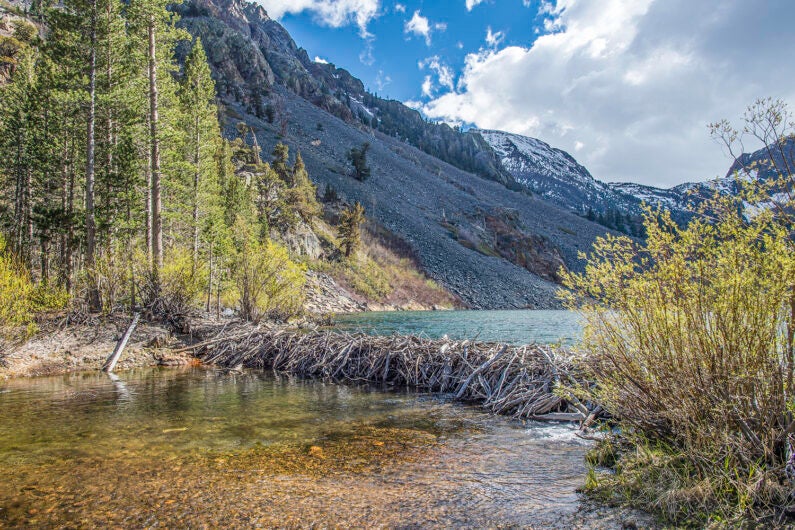What a surprise this must have come to every researcher at Stanford and anyone that isn’t me, It’s. making headlines all over this morning and that’s definitely a plus for beavers and the people who’d like to see more of them.
Beavers will become a bigger boon to river water quality as U.S. West warms, Stanford study finds
American beaver populations are booming in the western United States as conditions grow hotter and drier. New research shows their prolific dam building benefits river water quality so much, it outweighs the damaging influence of climate-driven droughts.
Let that sink in for a moment. Feel better?
As climate change worsens water quality and threatens ecosystems, the famous dams of beavers may help lessen the damage.

That is the conclusion of a new study by Stanford University scientists and colleagues, publishing Nov. 8 in Nature Communications. The research reveals that when it comes to water quality in mountain watersheds, beaver dams can have a far greater influence than climate-driven, seasonal extremes in precipitation. The wooden barriers raise water levels upstream, diverting water into surrounding soils and secondary waterways, collectively called a riparian zone. These zones act like filters, straining out excess nutrients and contaminants before water re-enters the main channel downstream.
This beneficial influence of the big, bucktoothed, amphibious rodents looks set to grow in the years ahead. Although hotter, arid conditions wrought by climate change will lessen water quality, these same conditions have also contributed to a resurgence of the American beaver in the western United States, and consequently an explosion of dam building.
Yes a few of us can do you a world of good. But a battalion of us can do things you never dreamed of, Now stop killing us and let us get to work,
“Completely by luck, a beaver decided to build a dam at our study site,” said Dewey, who is now a postdoctoral scholar at Oregon State University (whose mascot, incidentally, is a beaver). “The construction of this beaver dam afforded us the opportunity to run a great natural experiment.”
Right, Because who would EVER go out on purpose to STUDY beaver dams, This was just a fluke. I had no idea they saved water and restored the aquifer and made microclimates. I went to Stanford not UTAH state.
To understand how beaver dams may affect water quality in a future where global warming produces more frequent droughts and extreme swings in rainfall, the researchers compared water quality along a stretch of the East River during a historically dry year, 2018, to water quality the following year, when water levels were unusually high. They also compared these yearlong datasets to water quality during the nearly three-month period, starting in late July 2018, when the beaver dam blocked the river.
Okay you compared a wet year to a dry year. I’m pretty sure that’s been done. But not at Stanford. So what did you find?
Through their measurements and computer modeling of the interlinked biological, chemical, and physical processes that affect how contaminants become concentrated or flow downstream, the researchers found that the beaver dam dramatically increased removal of nitrate, a form of nitrogen, by creating a surprisingly steep drop between the water levels above and below the dam.
Warm, dry summers following spring snowmelt also produce big level changes, which generate a pressure gradient that pushes water into surrounding soils. The larger the gradient, the greater the flow of water and nitrate into soils, where microbes transform nitrate into an innocuous gas.
In the East River, the researchers found the increase in the gradient compared to an average day was at least 10 times greater with the dam than it was during the summer peak without the dam, for both the high-water year (2019) and the drought year (2018). Stated otherwise, the effects of the dam exceeded climatic hydrological extremes – in either direction of drought or abundant snowmelt – by an order of magnitude.
“Beavers are countering water quality degradation and improving water quality by producing simulated hydrological extremes that dwarf what the climate is doing,” said Fendorf, who is the Terry Huffington Professor in the Stanford Doerr School of Sustaienability and a senior fellow at the Stanford Woods Institute for the Environment
Do you hear that? Beavers are fixing our streams even FASTER than our climate can ruin them. That’s pretty darn fast,
“We would expect climate change to induce hydrological extremes and degradation of water quality during drought periods,” said Fendorf, “and in this study, we’re seeing that would have indeed been true if it weren’t for this other ecological change taking place, which is the beavers, their proliferating dams, and their growing populations.”
That nitrogen thing is a biggy I guess at Stanford. I mean when you add it to the list of all the other things beavers can do, like save water and increase biodiversity and save salmon and increase protection from FIRES it almost seems like a no brainer to keep as many of them as possible on the landscape
But what do I know?






































